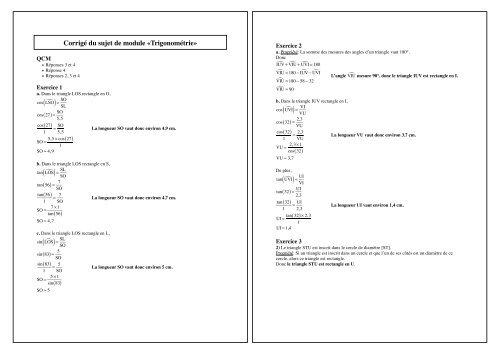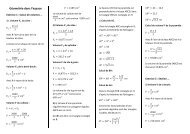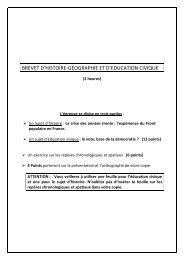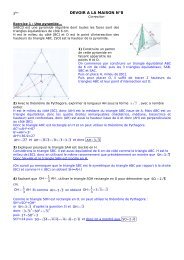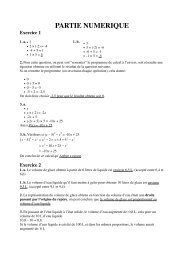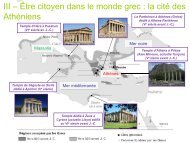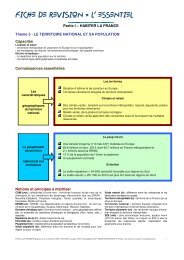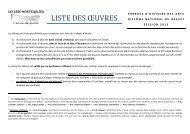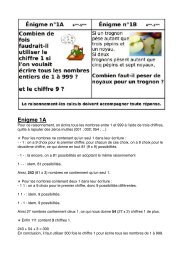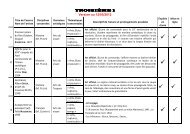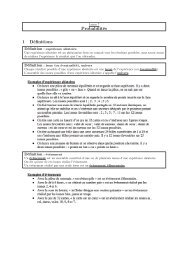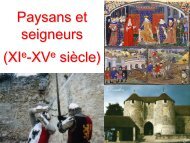Corrigé du sujet de module «Trigonométrie»
Corrigé du sujet de module «Trigonométrie»
Corrigé du sujet de module «Trigonométrie»
You also want an ePaper? Increase the reach of your titles
YUMPU automatically turns print PDFs into web optimized ePapers that Google loves.
QCM<br />
• Réponses 3 et 4<br />
• Réponse 4<br />
• Réponses 2, 3 et 4<br />
<strong>Corrigé</strong> <strong>du</strong> <strong>sujet</strong> <strong>de</strong> mo<strong>du</strong>le <strong>«Trigonométrie»</strong><br />
Exercice 1<br />
a. Dans le triangle LOS rectangle en O,<br />
( ) = SO<br />
cos LSO !<br />
SL<br />
cos( 27) = SO<br />
5,5<br />
( )<br />
1<br />
cos 27<br />
= SO<br />
5,5<br />
( )<br />
5,5 ! cos 27<br />
SO =<br />
1<br />
SO " 4,9<br />
b. Dans le triangle LOS rectangle en S,<br />
( ) = SL<br />
tan LOS !<br />
SO<br />
tan( 56) = 7<br />
SO<br />
( )<br />
1<br />
tan 56<br />
= 7<br />
SO<br />
SO = 7 !1<br />
tan 56 ( )<br />
SO " 4,7<br />
!! La longueur SO vaut donc environ 4,9 cm.<br />
! ! La longueur SO vaut donc environ 4,7 cm.<br />
c. Dans le triangle LOS rectangle en L,<br />
( ) = SL<br />
sin LOS !<br />
sin( 83) = 5<br />
SO<br />
( )<br />
1<br />
sin 83<br />
SO<br />
= 5<br />
SO<br />
SO = 5 !1<br />
sin 83 ( )<br />
SO " 5<br />
! ! La longueur SO vaut donc environ 5 cm.<br />
Exercice 2<br />
a. Propriété: La somme <strong>de</strong>s mesures <strong>de</strong>s angles d’un triangle vaut 180°.<br />
Donc<br />
IUV ! + VIU ! + UVI ! = 180<br />
VIU ! = 180 ! IUV ! ! UVI !<br />
VIU ! = 180 ! 58 ! 32<br />
VIU ! = 90<br />
! L’angle VIU ! mesure 90°, donc le triangle IUV est rectangle en I.<br />
b. Dans le triangle IUV rectangle en I,<br />
( ) = VI<br />
cos UVI !<br />
VU<br />
cos( 32) = 2,3<br />
VU<br />
( )<br />
1<br />
cos 32<br />
= 2,3<br />
VU<br />
VU = 2,3!1<br />
cos 32 ( )<br />
VU " 3,7<br />
De plus,<br />
( ) = UI<br />
tan UVI !<br />
VI<br />
tan( 32) = UI<br />
2,3<br />
( )<br />
1<br />
tan 32<br />
= UI<br />
2,3<br />
tan 32<br />
UI =<br />
UI " 1,4<br />
( ) ! 2,3<br />
1<br />
! ! La longueur VU vaut donc environ 3,7 cm.<br />
! ! La longueur UI vaut environ 1,4 cm.<br />
Exercice 3<br />
2) Le triangle STU est inscrit dans le cercle <strong>de</strong> diamètre [ST].<br />
Propriété: Si un triangle est inscrit dans un cercle et que l’un <strong>de</strong> ses côtés est un diamètre <strong>de</strong> ce<br />
cercle, alors ce triangle est rectangle.<br />
Donc le triangle STU est rectangle en U.
3) Dans le triangle STU est rectangle en U,<br />
( ) = SU<br />
ST<br />
( ) = 3 7<br />
sin STU !<br />
sin STU !<br />
STU ! ( 25,4<br />
! ! L’angle STU ! mesure environ 25,4°.<br />
STU ! = sin<br />
!1 " 3%<br />
#<br />
$<br />
7&<br />
'<br />
4) L’angle STU ! est un angle inscrit dans le cercle <strong>de</strong> diamètre [ST]. Il intercepte le petit arc SU ! .<br />
L’angle SOU ! est un angle au centre <strong>du</strong> même cercle. Il intercepte aussi le petit arc SU ! .<br />
Propriété: Si un angle inscrit dans un cercle et un angle au centre <strong>du</strong> même cercle interceptent le<br />
même arc <strong>de</strong> cercle, alors la mesure <strong>de</strong> l’angle au centre est le double <strong>de</strong> la mesure <strong>de</strong> l’angle inscrit<br />
dans le cercle.<br />
Ainsi,<br />
SOU ! = 2 ! STU !<br />
" 2 ! 25,4<br />
" 50,8<br />
L’angle SOU ! mesure donc environ 50,8°.<br />
Exercice 4<br />
2. Dans le triangle ABC rectangle en C,<br />
( ) = BC<br />
tan BAC !<br />
AC<br />
tan( 40) = BC<br />
5<br />
tan( 40)<br />
= BC<br />
1 5<br />
! ! La longueur BC vaut donc environ 4,2 cm.<br />
5 ! tan 40<br />
BC =<br />
BC " 4,2<br />
( )<br />
1<br />
3. a. Le triangle ABC est rectangle en C.<br />
Propriété: Le centre <strong>du</strong> cercle circonscrit à un triangle rectangle est le milieu <strong>de</strong> son hypoténuse.<br />
Donc le centre O <strong>du</strong> cercle circonscrit au triangle ABC est le milieu <strong>de</strong> [AB].<br />
4. L’angle BAC ! est un angle inscrit dans le cercle <strong>de</strong> diamètre [AB]. Il intercepte le petit arc BC ! .<br />
L’angle BOC ! est un angle au centre <strong>du</strong> même cercle. Il intercepte aussi le petit arc BC ! .<br />
Propriété: Si un angle inscrit dans un cercle et un angle au centre <strong>du</strong> même cercle interceptent le<br />
même arc <strong>de</strong> cercle, alors la mesure <strong>de</strong> l’angle au centre est le double <strong>de</strong> la mesure <strong>de</strong> l’angle inscrit<br />
dans le cercle.<br />
Ainsi,<br />
BOC ! = 2 ! BAC !<br />
= 2 ! 40<br />
= 80<br />
L’angle BOC ! mesure donc 80°.<br />
Exercice 5<br />
a) On appelle A le sommet <strong>de</strong> l’angle <strong>de</strong> 40°, P le pied <strong>du</strong> poteau et S le sommet <strong>du</strong> poteau.<br />
Dans le triangle APS rectangle en P,<br />
( ) = PS<br />
sin SAP !<br />
AS<br />
sin( 40) = PS<br />
20<br />
sin( 40)<br />
= PS<br />
1 20<br />
! ! La hauteur <strong>du</strong> poteau est environ 12,8 m.<br />
20 ! sin 40<br />
PS = 1<br />
PS " 12,8<br />
b) Pour représenter cette situation, l’échelle étant 1/200 , toutes les longueurs «réelles» sont<br />
divisées par 200. Par exemple, calculons la longueur <strong>du</strong> segment représentant le câble:<br />
20 ÷ 200 = 0,1<br />
or 0,1 m = 10 cm.<br />
Le câble sera représenté par un segment <strong>de</strong> 10 cm.<br />
On procè<strong>de</strong> <strong>de</strong> même pour trouver la longueur <strong>du</strong> segment représentant le poteau.<br />
12,8 ÷ 200 ! 0,064<br />
or 0,064 m = 6,4 cm.<br />
Le poteau sera représenté par un segment <strong>de</strong> 6,4 cm.<br />
Enfin, pour la construction, il faut trouver la mesure <strong>de</strong> l’angle ASP ! .<br />
Pour cela, on utilise:<br />
Propriété: La somme <strong>de</strong>s mesures <strong>de</strong>s angles d’un triangle vaut 180°.<br />
Donc<br />
ASP ! = 180 ! 40 ! 90<br />
= 50<br />
L’angle ASP ! mesure donc 50°.<br />
Programme <strong>de</strong> construction:<br />
tracer [PS] (le poteau) ;<br />
construire la perpendiculaire à [PS] passant par P (le sol) ;<br />
construire l’angle PSA ! <strong>de</strong> 50°, où le point A est l’intersection <strong>du</strong> côté tracé avec la droite (AP).
Exercice 6<br />
1. Dans le triangle CSH rectangle en H,<br />
( ) = CH<br />
sin CSH !<br />
SC<br />
sin( 80) = CH<br />
50<br />
sin( 80)<br />
= CH<br />
1 50<br />
! ! Le cerf-volant vole à une hauteur d’environ 49 m.<br />
50 ! sin 80<br />
PS = 1<br />
PS " 49<br />
2. Si la ficelle fait avec l’horizontale un angle <strong>de</strong> 40°, alors CSH ! = 40° .<br />
Dans le triangle CSH rectangle en H,<br />
( ) = CH<br />
sin CSH !<br />
SC<br />
sin( 40) = CH<br />
50<br />
sin( 40)<br />
= CH<br />
1 50<br />
40 ! sin 40<br />
PS = ( )<br />
1<br />
PS " 26<br />
La distance CH trouvée ne correspond donc pas à la moitié <strong>de</strong> celle calculée au 1.<br />
Exercice 7<br />
a. Propriété: La somme <strong>de</strong>s mesures <strong>de</strong>s angles d’un triangle vaut 180°.<br />
Dans le triangle AHC,<br />
ACH ! + CHA ! + HAC ! = 180<br />
ACH ! = 180 ! CHA ! ! HAC !<br />
ACH ! = 180 ! 90 ! HAC !<br />
ACH ! = 90 ! HAC !<br />
d. Dans le triangle ACH rectangle en H,<br />
( ) = AH<br />
CH<br />
( ) = 4,8<br />
tan ACH !<br />
tan ACH !<br />
6,4<br />
tan ACH ! 3! 1,6<br />
( ) =<br />
4 ! 1,6<br />
tan ACH !<br />
( ) = 3 4<br />
e. Dans le triangle BAH rectangle en H,<br />
( ) = BH<br />
tan BAH !<br />
tan BAH !<br />
AH<br />
( ) = BH<br />
4,8<br />
f. D’après la question c. , les angles ACH ! et BAH ! sont égaux. Donc tan ACH !<br />
D’après la question d., tan ACH !<br />
( ) = 3 4 .<br />
Donc, tan BAH !<br />
( ) = 3 4 .<br />
D’après la question e. , tan BAH !<br />
( ) = BH<br />
4,8 .<br />
Donc 3 4 = BH<br />
4,8<br />
3! 4,8<br />
, d’où BH = = 3,6 .<br />
4<br />
La longueur BH vaut donc 3,6 cm.<br />
g. D’après la question d. , tan ACH !<br />
( ) = 3 , donc ACH<br />
4<br />
L’angle ACH ! mesure environ 37°.<br />
! = tan<br />
!1 " 3%<br />
#<br />
$<br />
4 &<br />
' ( 37 .<br />
( ) = tan BAH !<br />
( ) .<br />
b. Les angles BAH ! et HAC ! sont adjacents, donc<br />
BAH ! + HAC ! = BAC !<br />
BAH ! + HAC ! = 90<br />
BAH ! = 90 ! HAC !<br />
c. Comme ACH ! et BAH ! sont tous <strong>de</strong>ux égaux à 90 ! HAC ! , alors les angles ACH ! et BAH ! sont<br />
égaux.


